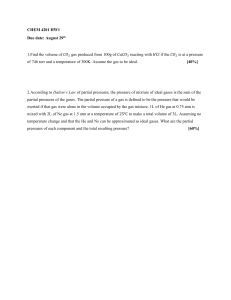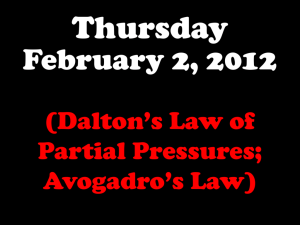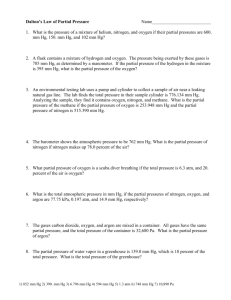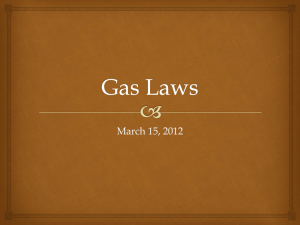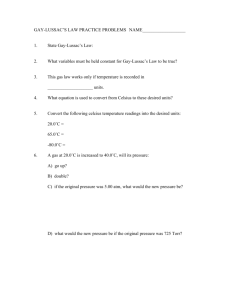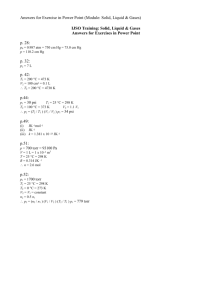Chem 10-11-117
advertisement
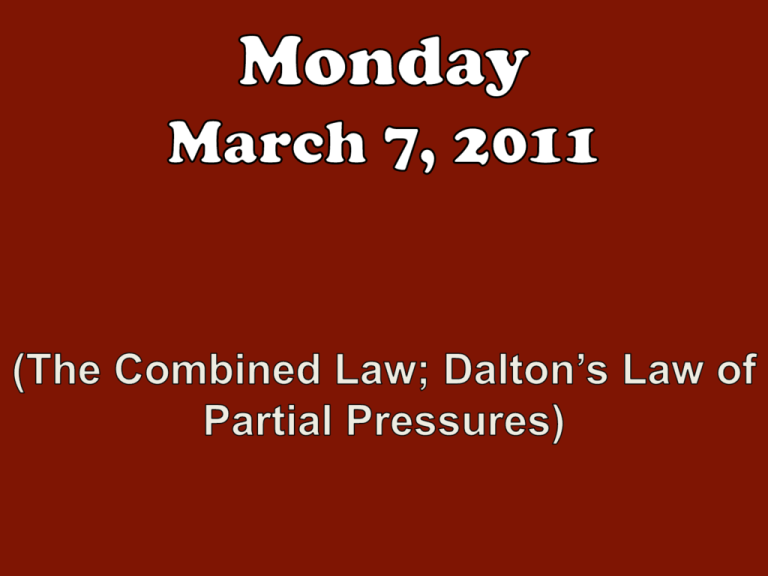
A sample of chlorine gas (Cl2) is at a temperature of 750C and is occupying a volume of 750 mL. If the temperature is increased to 980C, what will the resulting volume be? By what law? 800 mL Charles’ Law A sample of oxygen gas (O2) is at a temperature of 300C and a pressure of 435.876 kPa. If the temperature is decreased to 150C, what will the resulting pressure be? By what law? 414.298 kPa Gay-Lussac’s Law Announcements We will have ?? a test this Friday. Six-Week’s Assignment List Date Issued Date Due WS - The Kinetic Molecular Theory and Nature of Gases 2/24 3/3 Quiz – Pressure Unit Conversions 3/3 3/3 WS – The Gas Laws 3/3 3/10 Continue Worksheet The Gas Laws The Gas Laws • Boyle’s Law pressure – volume relationships • Charles’s Law volume - temperature relationships • Gay-Lussac’s Law pressure – temperature relationships • The Combined Gas Law volume – temperature – pressure relationships • Dalton’s Law of Partial Pressures partial pressures and total pressures • The Ideal Gas Law volume – temperature – pressure – mole relationships The Combined Gas Law •Volume – temperature – pressure changes • A gas sample often undergoes changes in temperature, pressure, and volume all at the same time. • When this happens, three variables must be dealt with at once. • Boyle’s law, Charles’s law, and Gay-Lussac’s law can be combined into a single expression that is useful in such situations. The Combined Gas Law •The Combined Gas Law expresses the relationship between pressure, volume, and temperature of a fixed amount of gas. •The combined gas law can be expressed as follows: •PV/T = k – k is constant and depends on the amount of gas. The Combined Gas Law •The combined gas law can also be written as follows. P1V1/T1 = P2V2/T2 –The subscripts in the equation above indicate two different sets of conditions, and T represents Kelvin temperature. –From this expression, any value can be calculated if the other five are known. The Combined Gas Law Sample Problem • A helium-filled balloon has a volume of 50.0 L at 25°C and 1.08 atm. What volume will it have at 0.855 atm and 10°C? • Unknown is V2 of helium in L. P1V1/T1 = P2V2/T2 V2 = P1V1T2/P2T1 V2 = (1.08 atm)(50.0 L He)(283 K)/(0.855 atm)(298K) V2 = 60.0 L He Dalton’s Law of Partial Pressures John Dalton, the English chemist who proposed the atomic theory, also studied gas mixtures. He found that in the absence of a chemical reaction, the pressure of a gas mixture is the sum of the individual pressures of each gas alone. Dalton’s Law of Partial Pressures This picture shows a 1.0 L container filled with oxygen gas at a pressure of 0.12 atm at 0°C. In another 1.0 L container, an equal number of molecules of nitrogen gas exert a pressure of 0.12 atm at 0°C. The gas samples are then combined in a 1.0 L container. (At 0°C, oxygen gas and nitrogen gas are unreactive.) The total pressure of the mixture is found to be 0.24 atm at 0°C. The pressure that each gas exerts in the mixture is independent of that exerted by other gases present. The pressure of each gas in a mixture is called the partial pressure of that gas. Dalton’s Law of Partial Pressures Dalton’s law of partial pressures states that the total pressure of a mixture of gases is equal to the sum of the partial pressures of the component gases. The law is true regardless of the number of different gases that are present. Dalton’s law may be expressed as follows: PT = P1 + P2 + P3 + . . . PT is the total pressure of the mixture. P1, P2 , P3, . . . are the partial pressures of component gases 1, 2, 3, and so on. Dalton’s Law of Partial Pressures Sample Problem Three of the primary components of air are carbon dioxide, nitrogen, and oxygen. In a sample containing a mixture of only these three gases at exactly one atmosphere pressure, the partial pressures of carbon dioxide (PCO2) = 0.285 torr and nitrogen (PN2) = 593.525 torr. What is the partial pressure of oxygen? PT = P 1 + P 2 + P 3 + . . . Pair = PCO2 + PN2 + PO2 Pair = 1 atm = 760.000 torr 760.000 torr = 0.285 torr + 593.525 torr + PO2 PO2 = 760.000 – 0.285 – 593.525 = 166.190 torr Worksheet Dalton’s Law of Partial Pressures
